Paul was the second Overseer of Girraween National Park.
[Interview questions by Vanessa Ryan.]
When did you work in Girraween National Park, Paul?
From December 1972 to November 1981.
How many years would that have been?
Almost nine years.
|
|
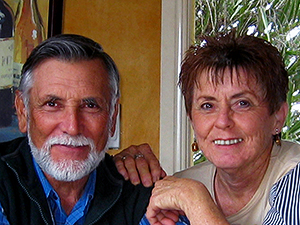
Paul and Leanne Grimshaw
|
|
Had you ever been to Girraween before starting work here?
No.
How did you come about working in Girraween?
After being employed as a workman at Carnarvon National Park for 18 months, I decided to apply for the vacancy of Overseer-in-charge at Girraween NP. Even with my short employment period as a workman, I was unexpectedly successful and got my promotion and became the Overseer-in-charge at Girraween NP.
Who were the staff working with you?
When I first started I only had one assistant workman - Hock Goebel. It wasn't until a year or so later that Hock's brother Bill was also employed to work at Girraween.
What sort of duties did you undertake while you were working in Girraween?
As the term Overseer implies, I was in charge of the day to day running of the National Park. My duties included ordering materials and equipment; I directed and organised other park staff's duties; I issued camping permits for camping in the park; I provided visitors with natural resource information and answered questions regarding Girraween. This included giving guided walks and giving slide talks about Girraween and its natural history. On days when the other staff was rostered off, I emptied rubbish bins and cleaned the amenities blocks. While it wasn't necessarily required of my position, I carried out flora surveys and collected plant specimens for identification at the Queensland Herbarium. I also recorded incidental fauna records and submitted specimens to the Queensland Museum for identification. As Firewarden for the Wyberba District, I issued fire permits for controlled burning on private properties.
What would have been your biggest achievement while you were working in Girraween?
While I wasn't directly involved, I indirectly facilitated the extensions to Girraween National Park - extensions which almost doubled the parks total area during my time there. The extent of my involvement was keeping Central Office acquisition officers informed regarding the significance and strategic value of various areas adjoining the park and the need to acquire them. I also informed them when blocks came up for sale, particularly those where the landowners were particularly unsympathetic to the natural environment.
|
|
Did you experience any major fires, floods or other natural disasters? If so, what happened?
Although we fought a number of bush fires, Girraween only experienced one really severe bushfire while I was there. This was in the late 1970's when a fire came from the Qld/NSW border near South Bald Rock and threatened to burn out of control through much of the park. The fire threatened to race along Dingo Swamp, which ran past South Bald Rock on its western flank. It took all our (myself and four other staff) efforts to create a firebreak (before the fire got there) across the narrowest part of the swamp to link up with a 4wd track, which connected to the West Bald Rock track. It was our plan to back burn from this fire-line to the approaching wildfire, which we did just at a critical time as the fire got very close. It was extremely scary as the fire approached. It sounded like a runaway express steam train at close quarters. Luckily we were able to halt the wildfire at that time, but the next day the fire started up again on another front. Fortunately a couple of days later rain came and doused the fire completely.
There was a massive flood in Girraween in February 1976 when the Bald Rock Creek became a raging roaring torrent. At the picnic ground crossing and at the Junction, when the force of the water hit submerged boulders in the creek bed, it sent plumes of spray metres into the air. By contrast, only 14 months later (in April 1977) during a serious drought period, Bald Rock Creek at the Junction had completely stopped running.
Did it ever snow during your time working in Girraween?
Yes it snowed only once while we were living at Girraween. It started snowing during a Sunday night and lasted until mid-morning Monday. That was in the winter of 1978. Once the sun came out the snow didn't last long on the ground. However on sheltered parts of the first Pyramid it lasted until Tuesday morning.
Where did you live while working in Girraween?
Leanne and I lived in Gunn's house for the duration of our stay.
|
|
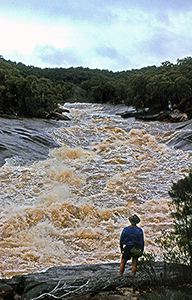
February 1976.
Carpenter Ray Rock observing
the flooding at the Junction.
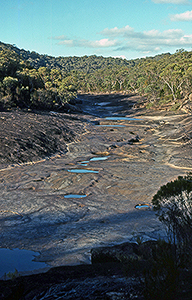
April 1977.
The same locatation a little over
a year later and it's in drought.
|
|
What did Leanne do while you were working in Girraween?
Leanne spent most of our time at Girraween doing a variety of things - including fruit picking on neighbouring orchards, fruit bottling, cooking, sewing and dress-making for friends and customers, lots of reading, bush walking and enjoying the nature of Girraween, socialising with and hosting visiting friends and family. Leanne especially enjoyed her weekly shopping trips into Stanthorpe, where she met and got to know some of the townspeople.
When I was absent from the office, Leanne often answered the official phone and gave out information to the public. Leanne also was a contract cleaner of the Visitor Centre/Office for over 12 months shortly after it was built. However she was only paid to clean the building interior once a week, whereas it required more cleaning due to the dust from the adjacent dirt road. QPWS Central Office wouldn't agree to reimburse her for carrying out cleaning more often than the one day a week. As a result Leanne decided to terminate her cleaning contract. To be honest, Leanne was my right-hand person and support as far as my job was concerned. However the QPWS hierarchy never considered employing National Park Overseer/Ranger wives on a full-time basis back in the 1970's or 1980's.
Did family and friends explore much of the park with you?
We had lots of friends and family who visited us at Girraween while we were there. We were always keen to take them on walks and show many of the spectacular features in the park, particularly when I was off duty. We also showed them around the Stanthorpe District while they were staying with us.
What is your fondest memory of your time working at Girraween?
It is difficult to single out one fondest memory during my time at Girraween as there are so many that are equal. Generally discovering unfamiliar species that I had never seen or witnessed before, such as seeing a new ground orchid, or discovering a frog, gecko or a plant species I was unfamiliar with.
|
|
Do you both have any particular interests that you developed during your time at Girraween?
Working and living at Girraween gave me the opportunity to develop and hone my photography skills, especially with close-ups of flora and fauna. I became particularly intrigued and fascinated with ground orchids, because Girraween was rich with a wide variety of them. Some ground orchid species would flower only once every three or four years and then only stay open for one day. It therefore would give me such a thrill when I was fortunate enough to find them flowering and be able capture them with my camera.
I believe another of your interests is painting and drawing? Can you tell us a bit about that?
I was keen on art as a child and always got great remarks about my artwork at school. I won first prize in the open section of the Sunday Mail Children's Art Competition when I was 14. In my mid to late teens I took art lessons in both watercolour and oil mediums. When I was in my late 20's up until my late 30's I did landscape painting in oils. When I was based at Carnarvon and Girraween National Parks I painted and sold a few landscape paintings or gave them to friends. I have promised myself I will take up painting again, but I keep procrastinating because at present I have far too many other interests to occupy my time.
Some of your botanical drawings were used in the Book on Girraween and Bald Rock's flora and fauna. You also co-authored it. How did that book come about?
I struck up a friendship with botanist Bill McDonald when he used to visit Girraween National Park while I was the Overseer in Charge there. I regard Bill as a great friend and my botanical mentor. We used to go on walks, looking at and collecting plant specimens in the park and we started to compile a species list from what we saw and collected. It was Bill's idea to eventually produce a book on the flora of Girraween and Bald Rock National Parks. It was finally published in 1995, well after I had left Girraween. Bill decided to include myself, Colleen Gravatt (Girraween Interpretive Officer) and John Williams (Botanist University of New England) as co-authors. As co-authors, we three contributed some of the art work such as photos, line drawings and diagrams.
Do you have any interesting stories or anecdotes you'd like to share?
Our time at Girraween was very eventful. There are so many interesting and sometimes amusing stories to tell that there is not enough space to relate them here. I have recorded many of them in my memoirs.
|
|
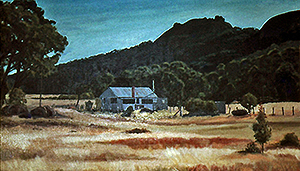
Hock and Betty Goebel's house near the Pyramids.
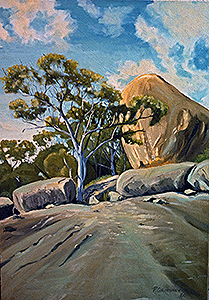
Boulders and Wallangarra White Gum, Mt Norman.
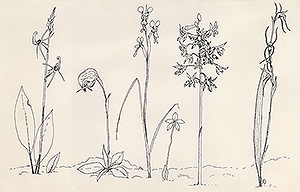
Botanical drawings of Orchids.
|
|
What was your reason for leaving Girraween?
After being the Overseer in charge at Girraween National Park for eight and a half years, I started to feel that I was becoming too protective and possessive of the park, and that maybe it was time for me to move on. Girraween had grown in public popularity and visitation had increased to the extent that I started to see people as a threat to what I regarded as my "turf". The QPWS Deputy Director and the Southeast Region Superintendent had hinted more than once that I should consider a change. Eventually I was offered a position as an Overseer in Brisbane, whose duties were to coordinate park projects and give support to park field staff throughout the Southeast Region. I was very reluctant to leave the Granite Belt and Stanthorpe area as I loved the climate and the local district had become very dear to me and Leanne.
I had heard a rumour that Girraween and the Granite Belt was soon to become the base for a National Park District Centre. However when I asked the Regional Superintendant if I could be considered for the position as District Ranger he denied that there was going to be a district for the Granite Belt area and, even if there was, I wasn't qualified for such a position. It was at this juncture I decided to take the Overseer position in Brisbane. Ironically, not long after I left Girraween it became a District Centre and the District Ranger lived in Gunn's house. However, I eventually had the last laugh, as later in my career I became the District Ranger for the Scenic Rim with or without the appropriate qualifications.
Do you come back here for holidays?
My wife and I have returned to stay in or near Girraween NP on numerous occasions due to our love for the area. As recently as July last year, we and a group of friends, who used to visit us while we lived here, had a back to Girraween weekend. We all walked to Dr Roberts Waterhole and the Underground River, where we had a picnic lunch on the rocks and reminisced about the good old (Girraween) days. In February this year (2016) we also returned to Girraween NP for the 50th Anniversary celebration, which we enjoyed immensely.
Has much changed since you were here last?
Since we left Girraween in 1982 and returned for visits over the last 34 years we have noticed many changes - some gradual and some rapid.
We have seen considerable changes to Gunn's House since we lived in it. The surrounding fences have gone and the native plant gardens we grew around the house are no longer evident. The interior of the house has been somewhat gutted to accommodate displays, storage and a theatrette. However some of the original and seventies decor still does exist within parts of the interior.
The most notable change has been the growth of vegetation in an around the picnic ground and the Castle Rock camping area. When we first arrived at Girraween in December 1972 the tree cover on the picnic ground was relatively sparse. Splendid views of features such as the Pyramids and Slip Rock could be easily seen from Gunn's House due to the lack of tree cover. Views like this are no longer visible from this location.
Where the Castle Rock camping area is now was a stone fruit orchard when we arrived. During our stay at Girraween the fruit trees were removed and the camping area was developed and landscaped and a new amenities block was built within it. It took quite a while for the trees and shrubs we planted to grow so originally there were great vistas of the Pyramids and ridges beyond from most parts of this camping area.
When we visited Girraween earlier this year for the 50th Anniversary celebrations we made a special point of visiting the Castle Rock camping area just to see how much the vegetation had grown and to take pictures of it. We were overwhelmed with what we saw in the amazing growth of the trees which I and the staff had grown and planted at the start of its development. Leanne and I took lots of photos to compare with the ones I had taken during and just after the camping area was developed. The difference is like "Chalk and Cheese".
Thank you.
The following are some of Paul's photos of the Castle Rock camping area, taken back in 1977/1980 and the ones he took of it in February 2016. The two shot comparisons are taken from almost exactly the same spots 39 years apart.
|
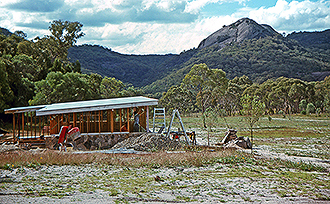
July 1977. Ray Rock and Johnny Rogers working on the amenities construction in Castle Rock camping area.
|
|
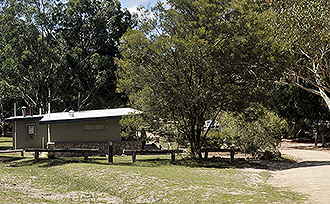
February 2016. The Castle Rock camping area amenities block.
|
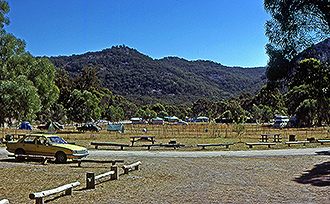
April 1980. The recently opened Castle Rock camping area, before vegetated areas became established.
|
|
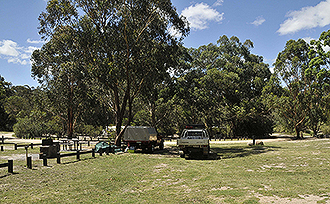
February 2016. The Castle Rock camping area with well established vegetation.
|

